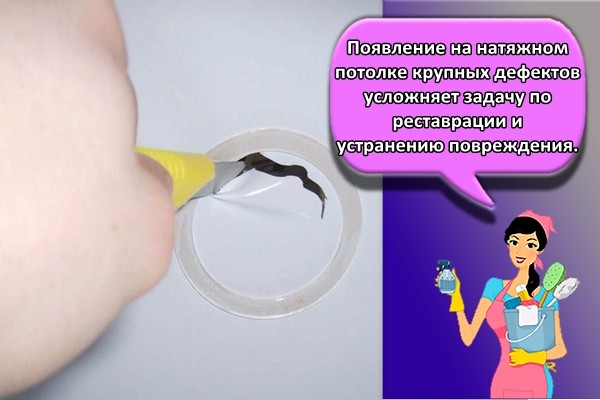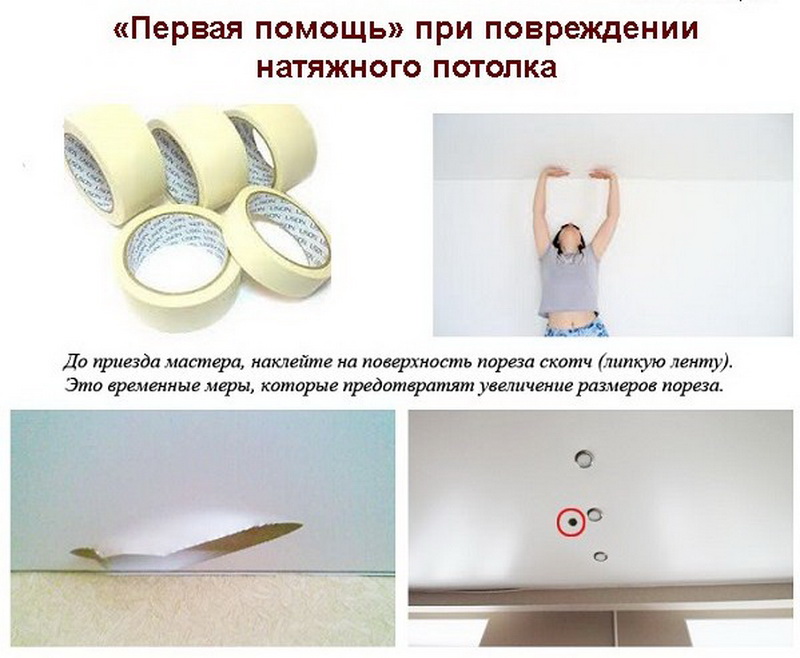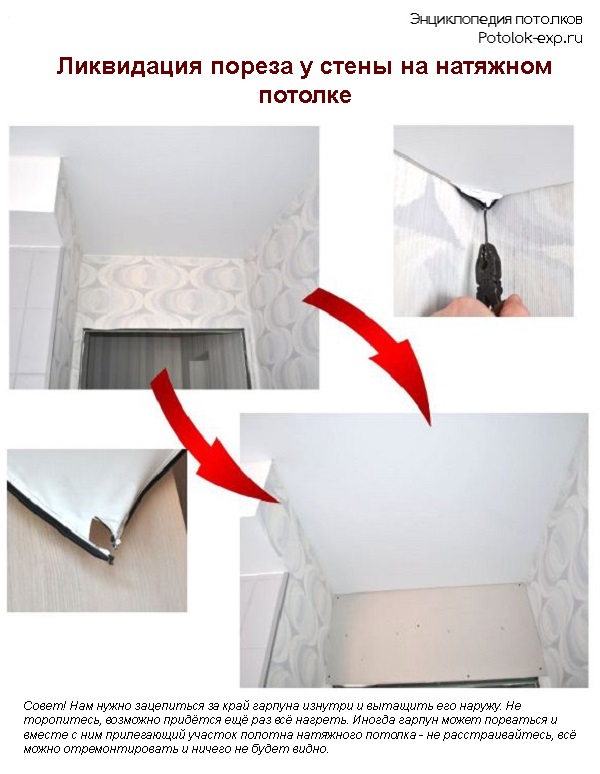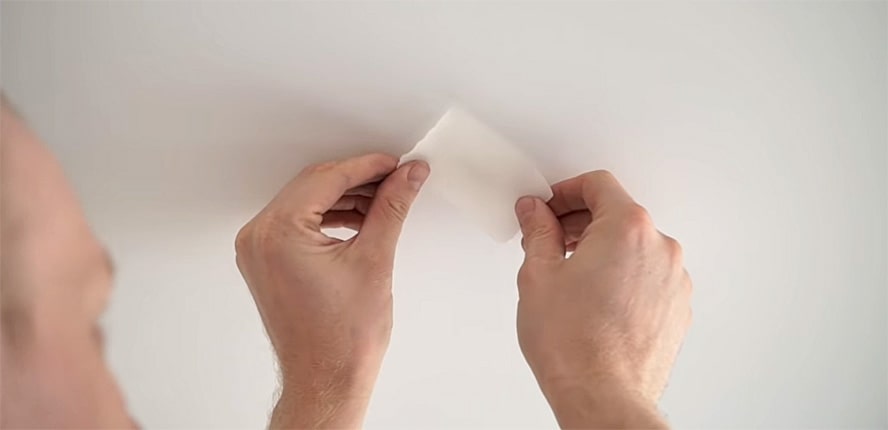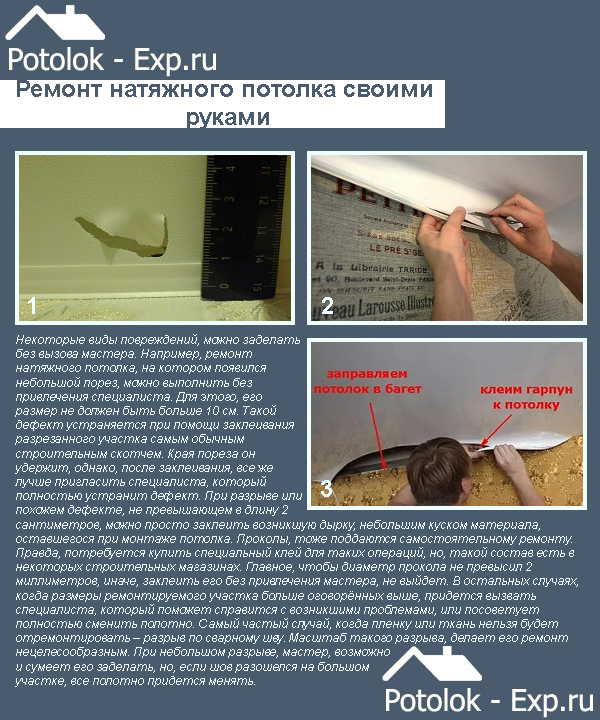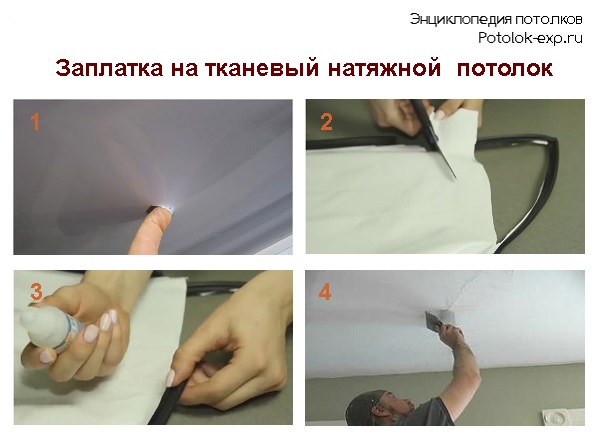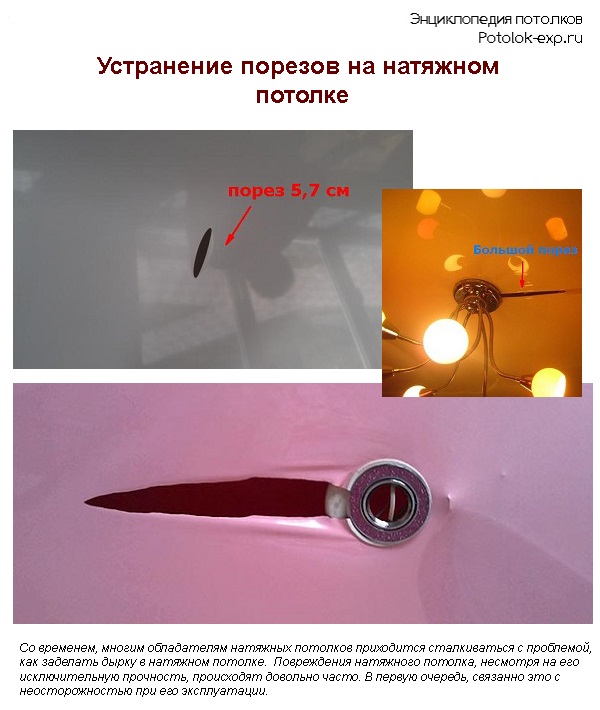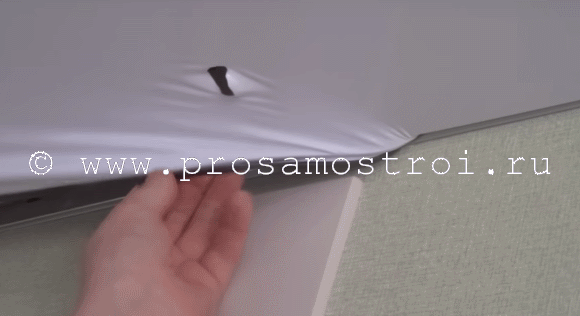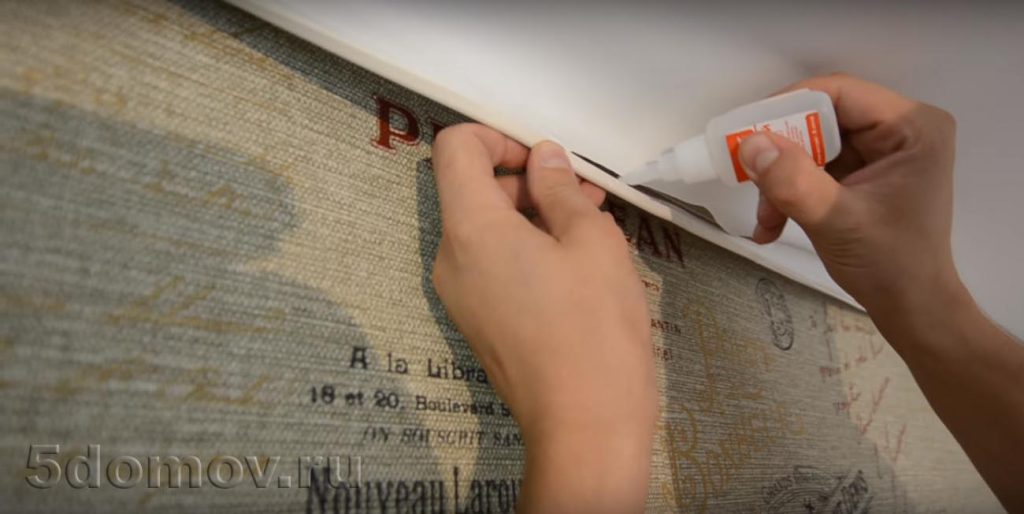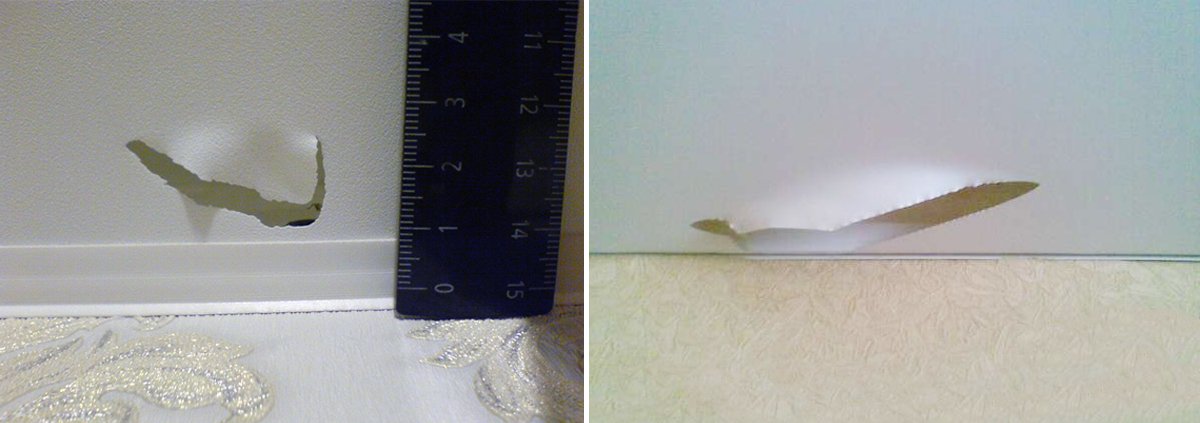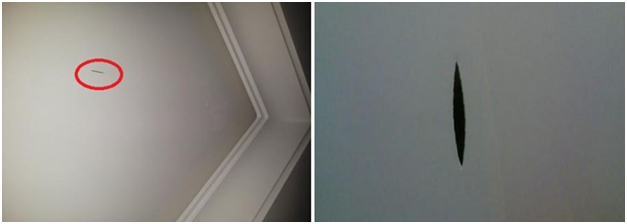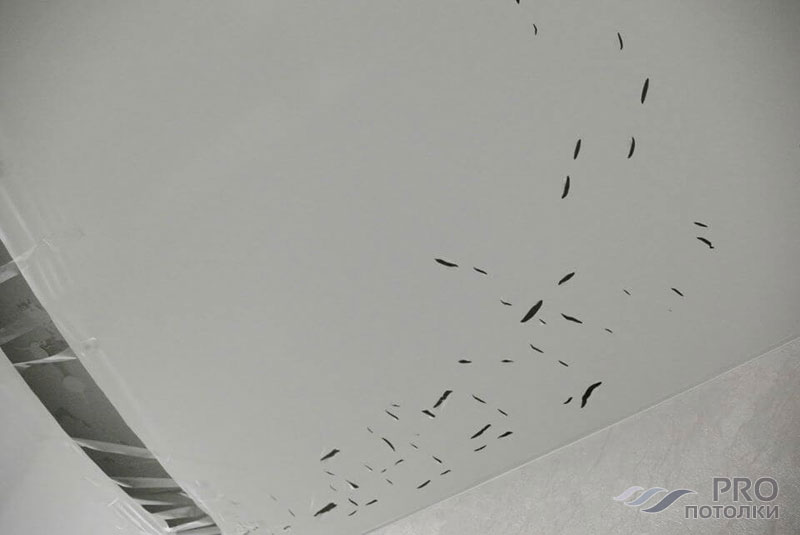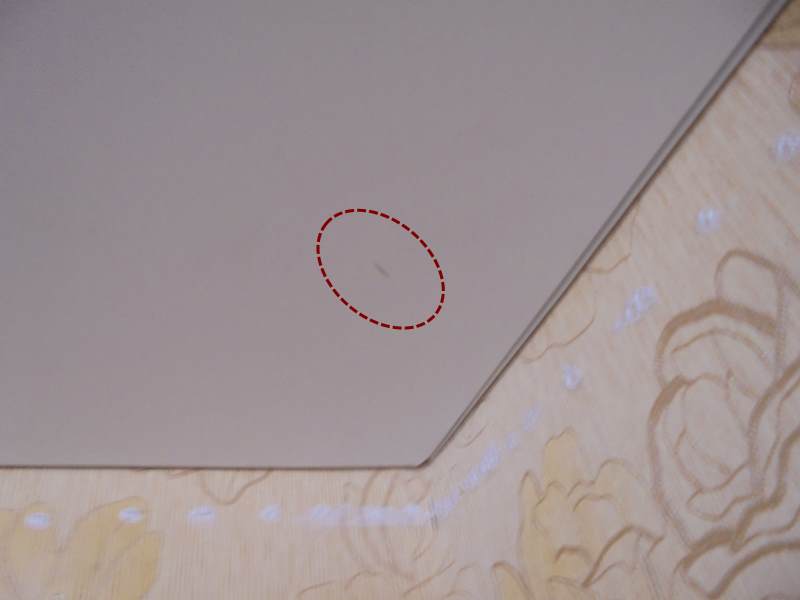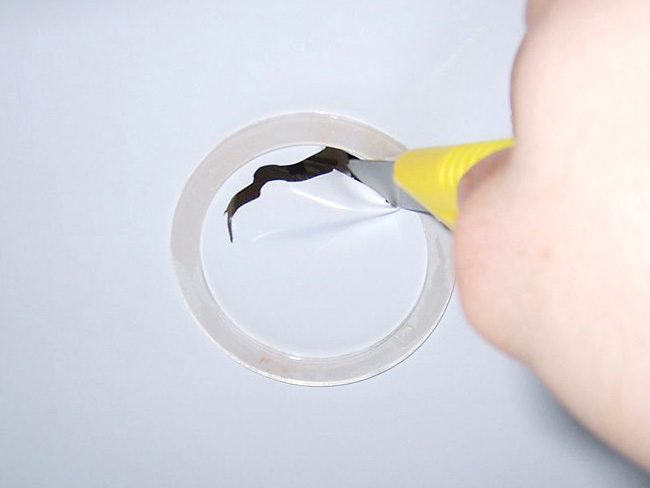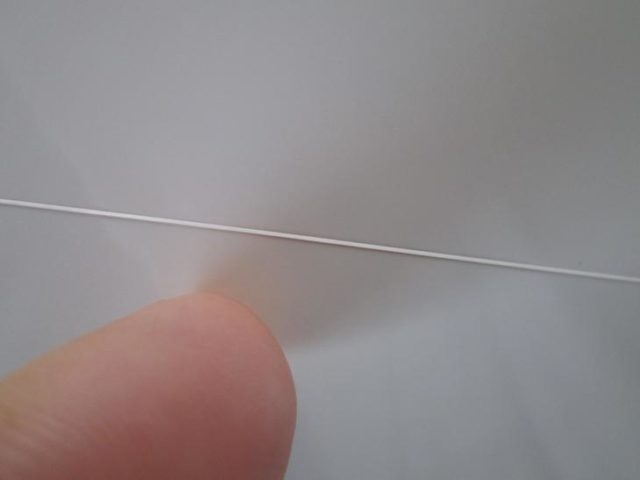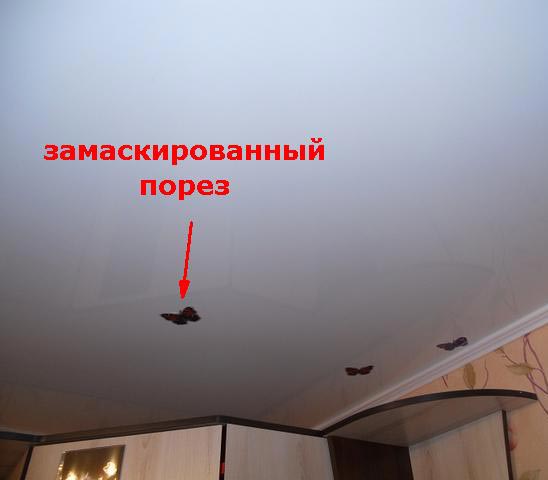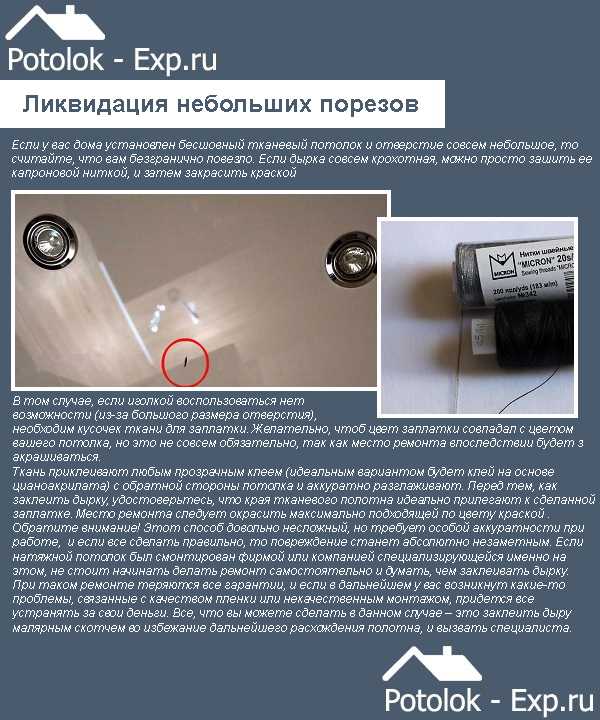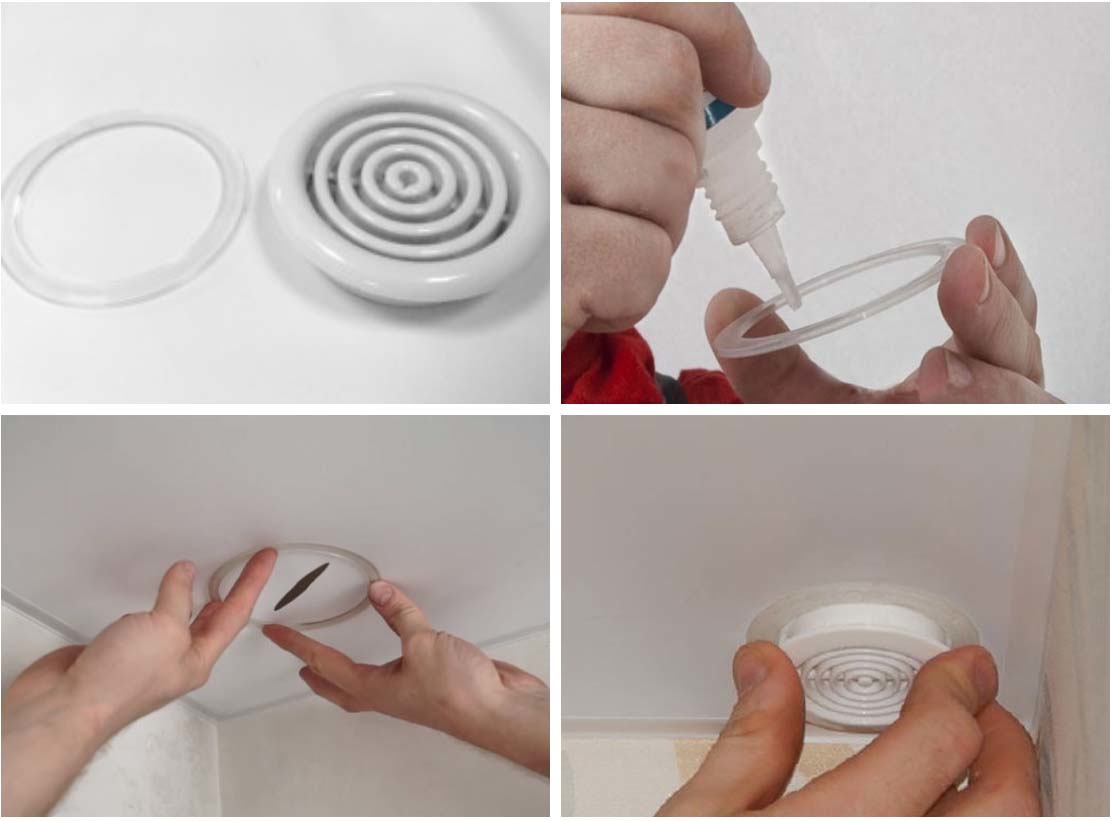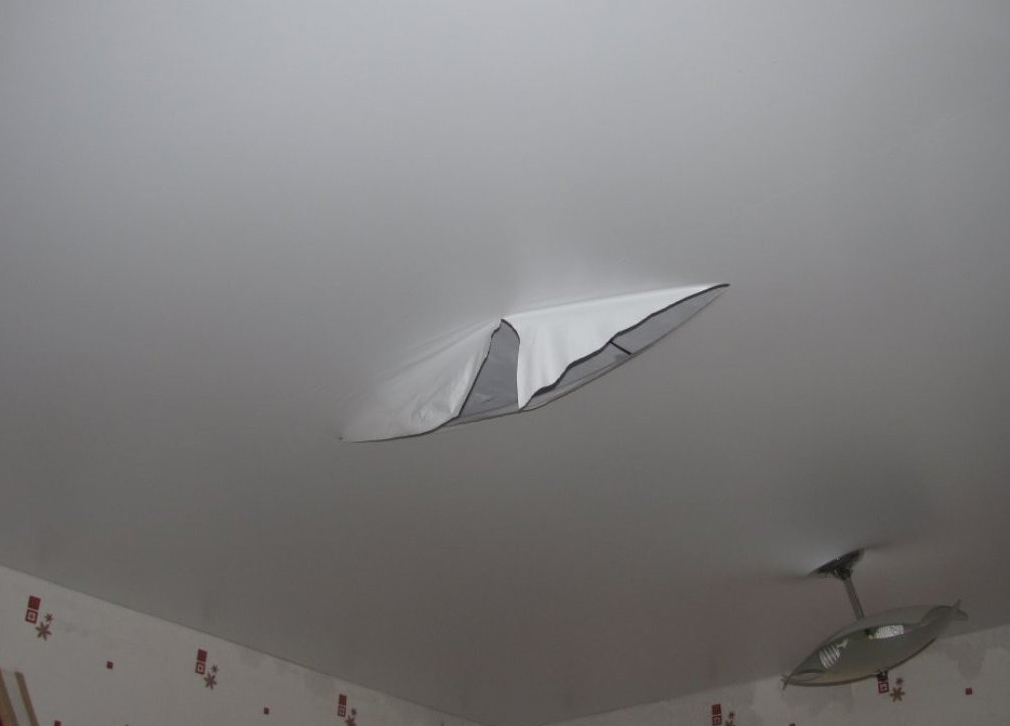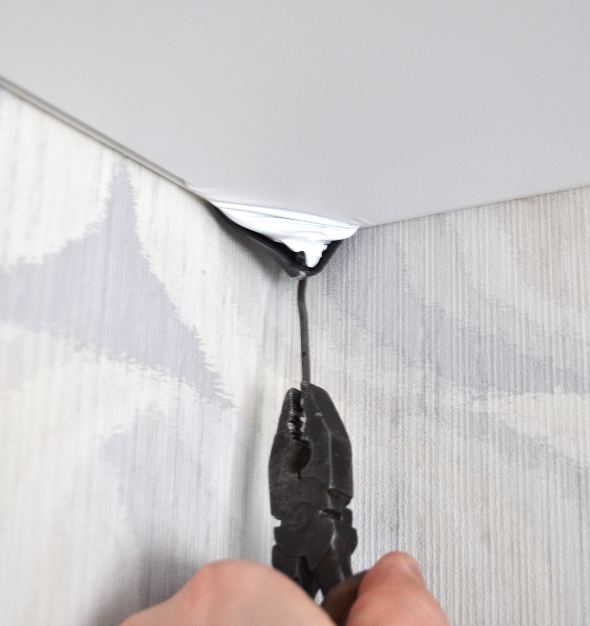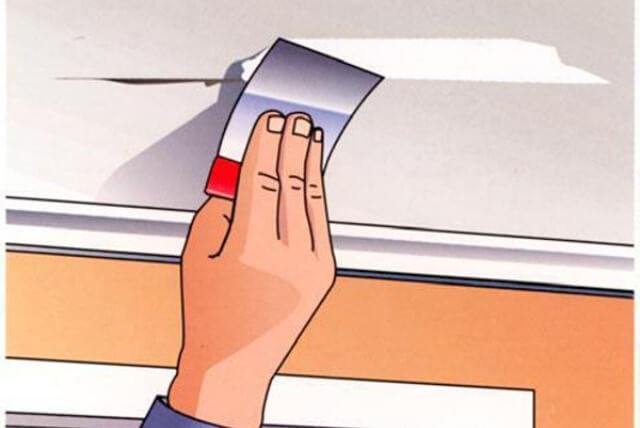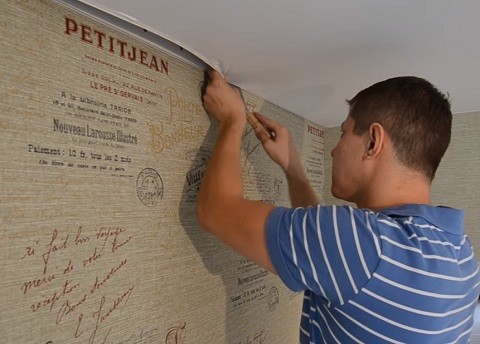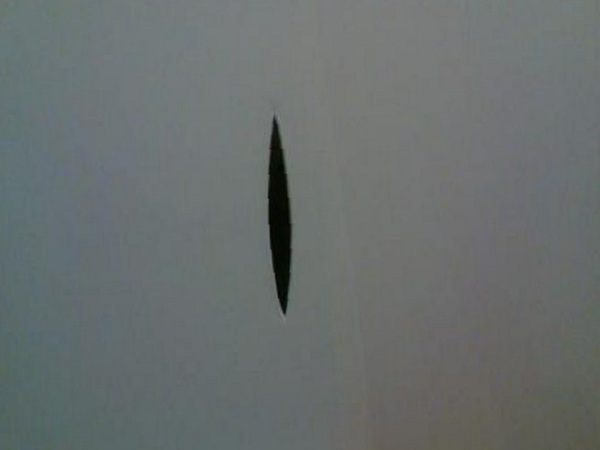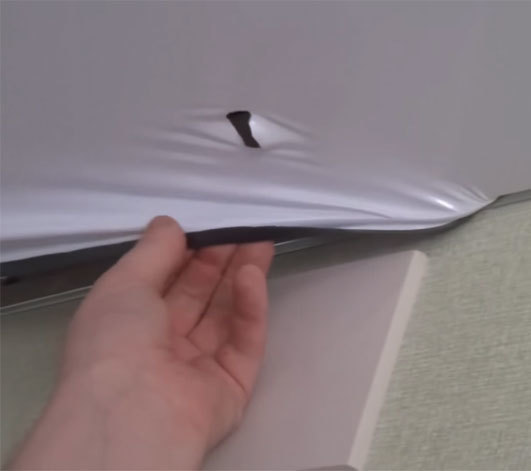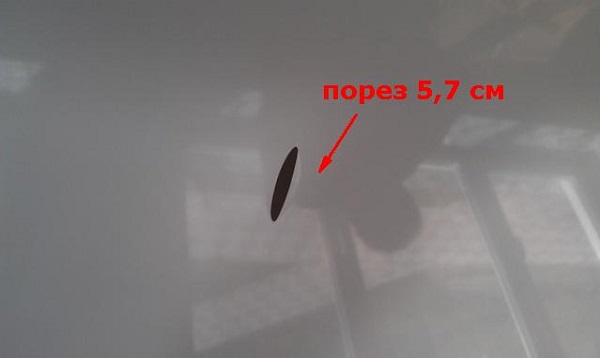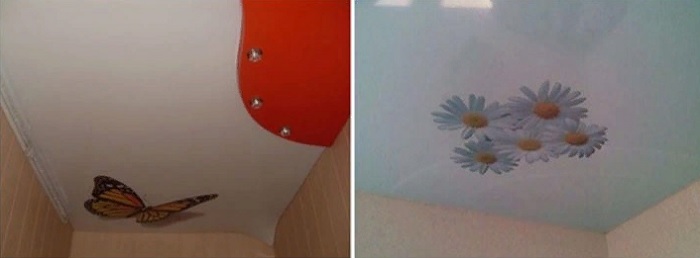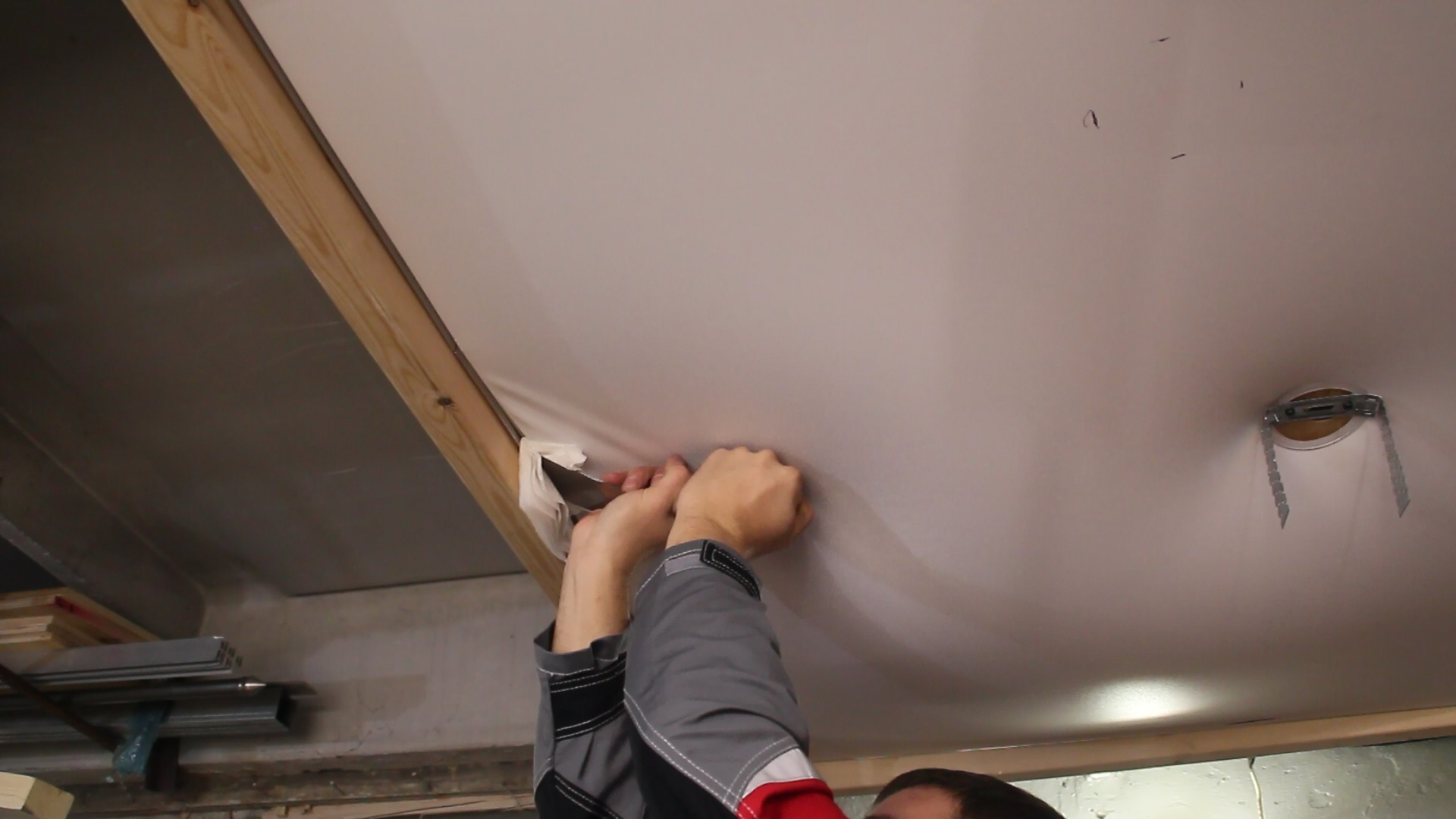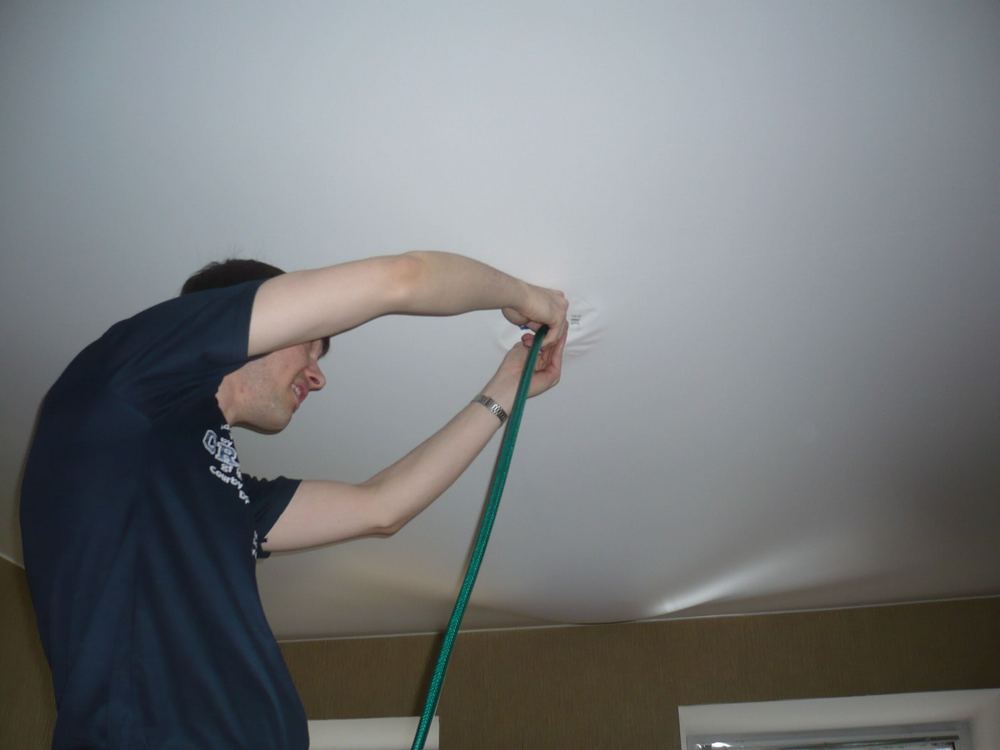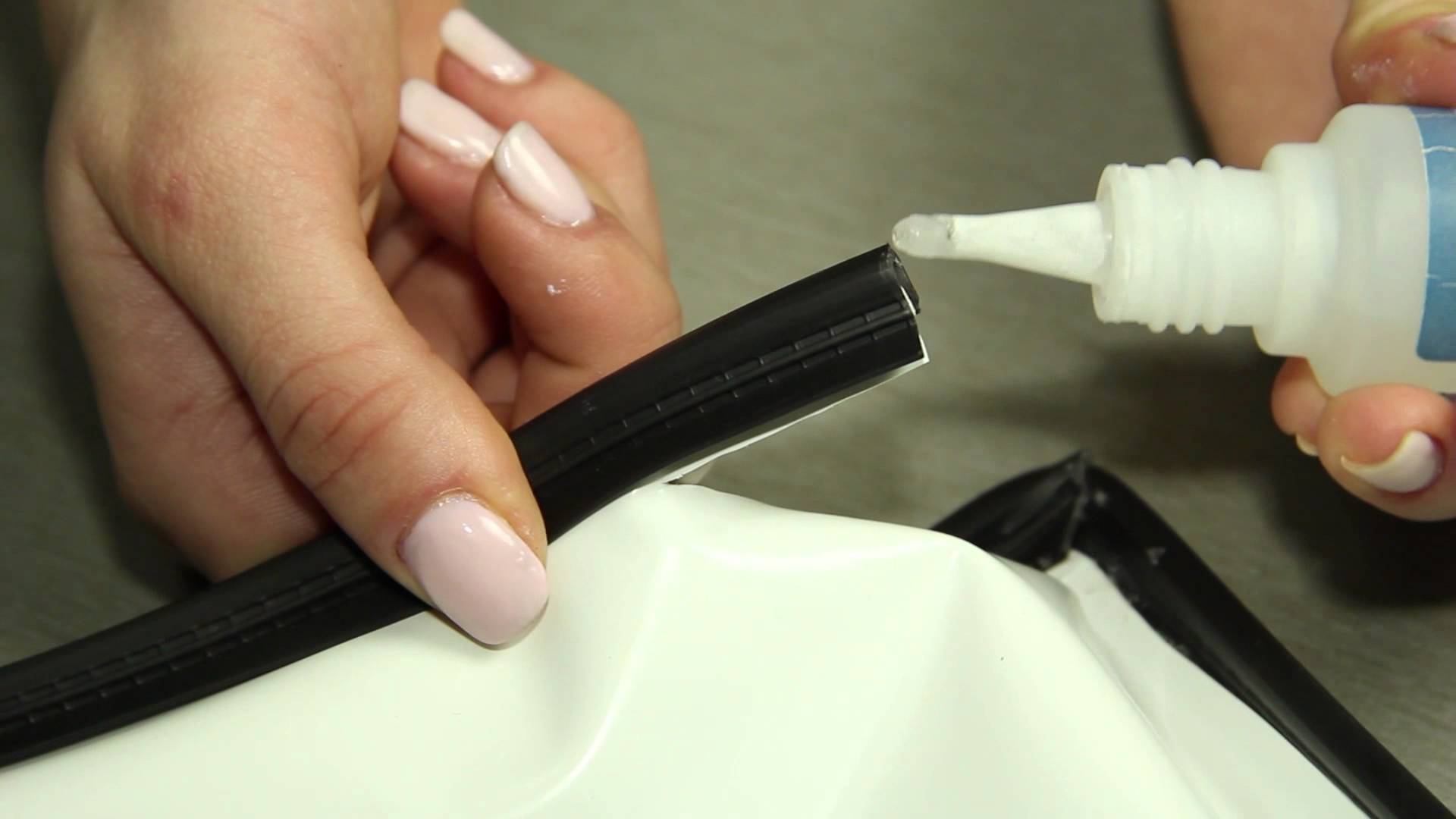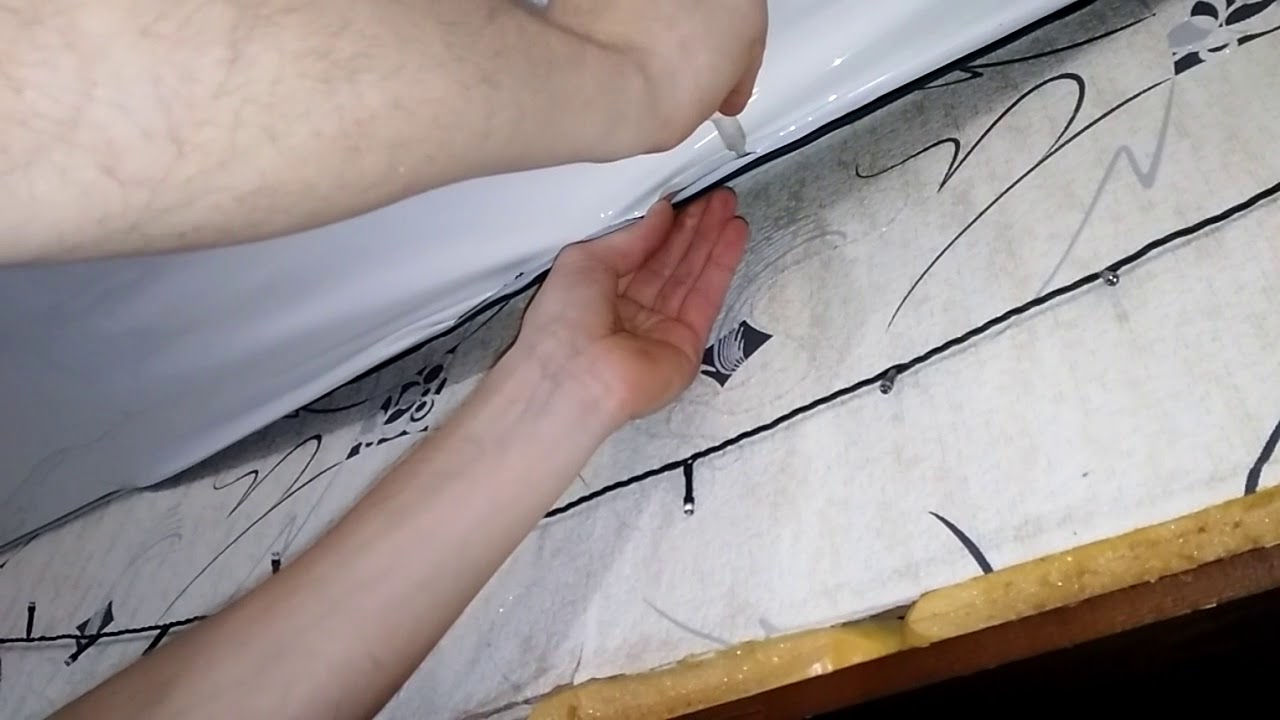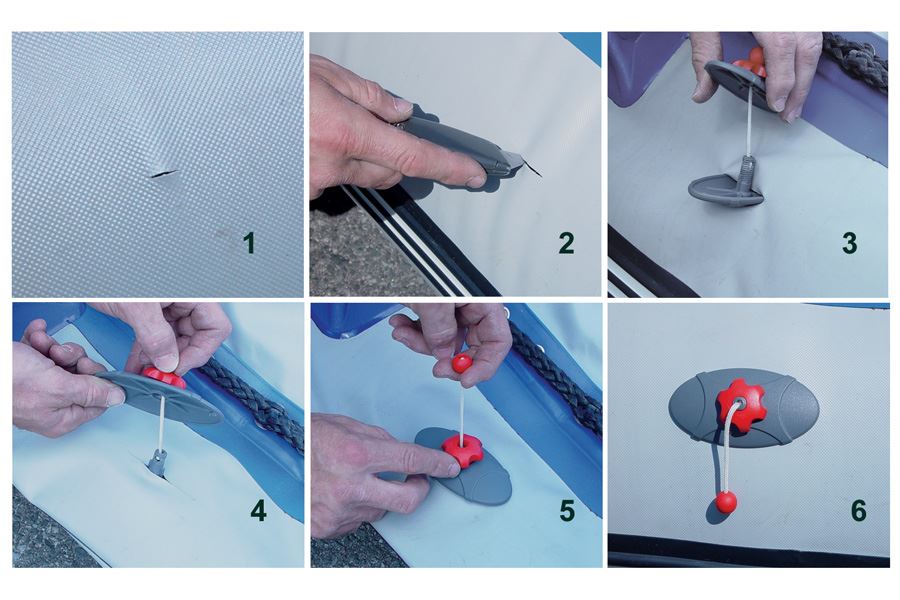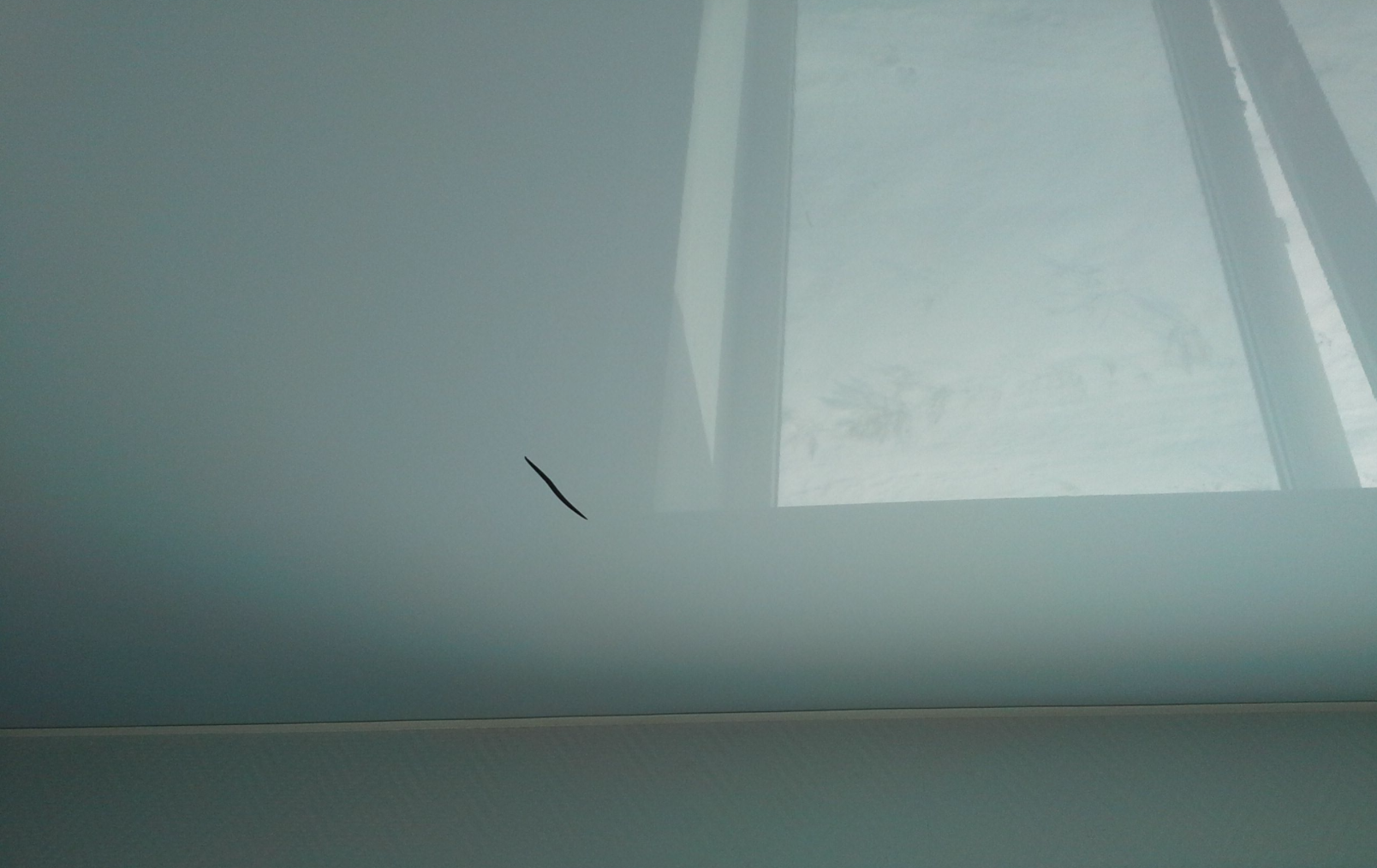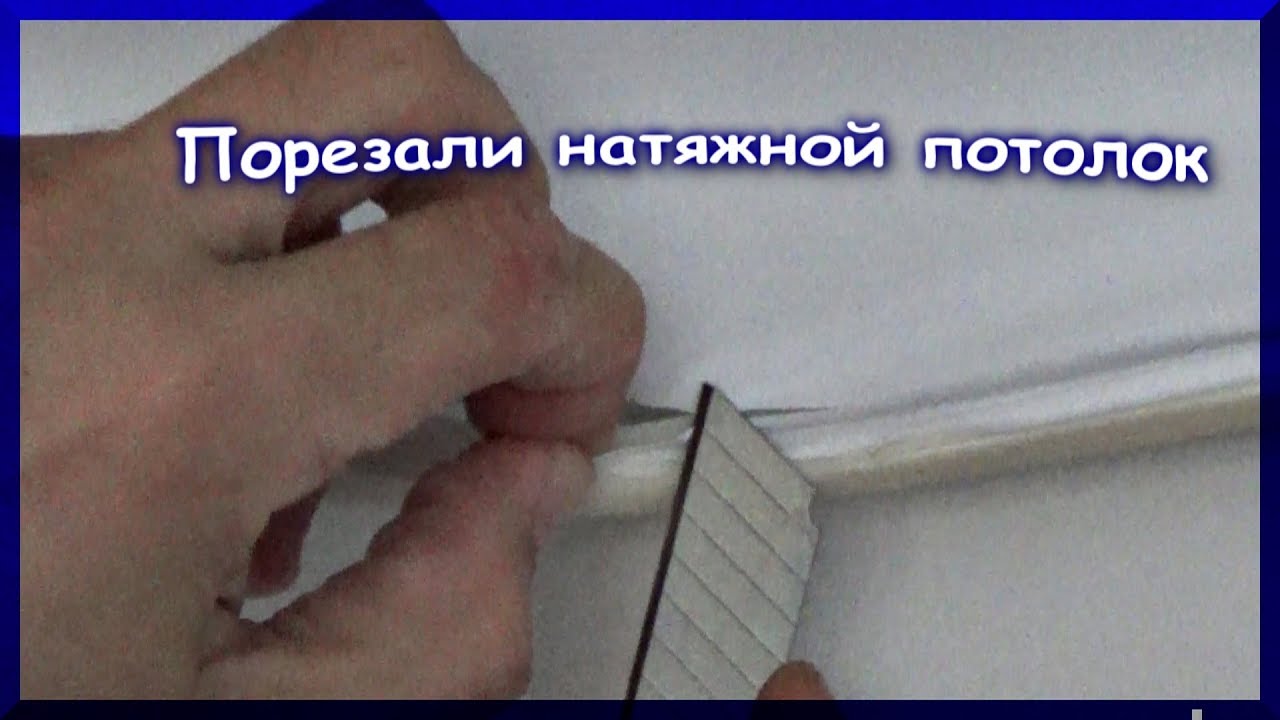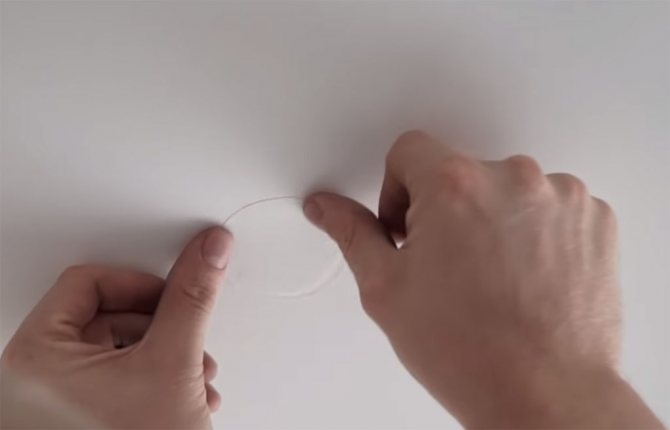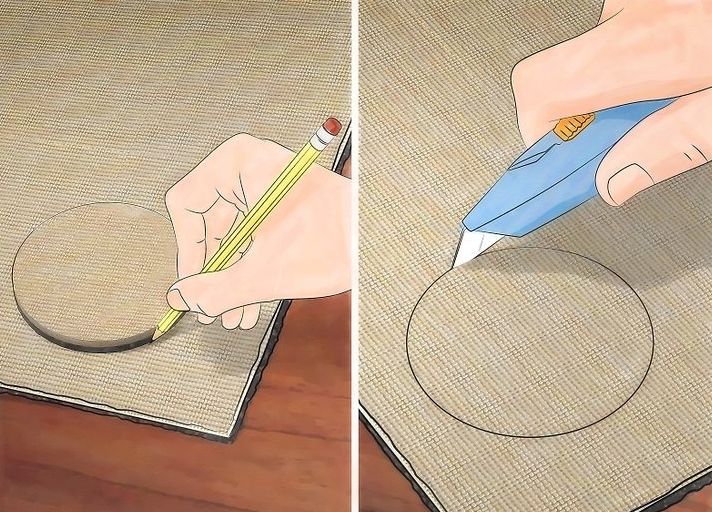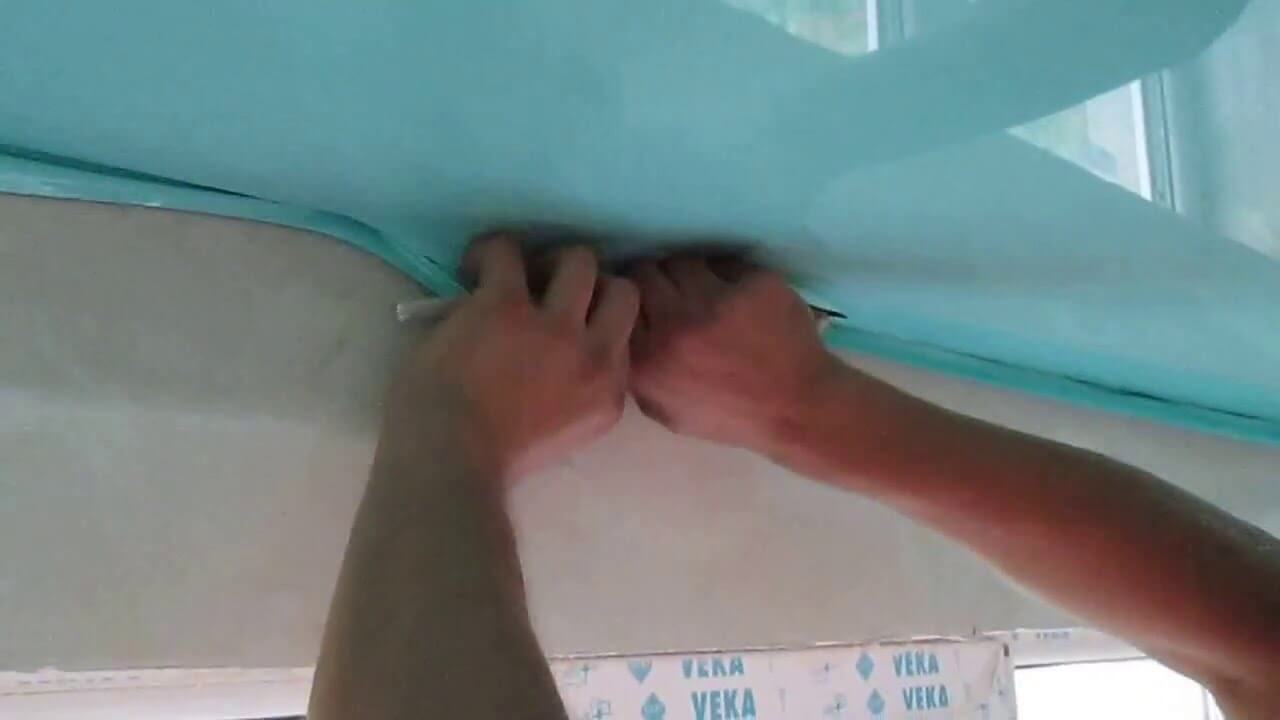What cases are covered by the warranty?
Before plugging the hole, pick up the contract with the contractor and re-read all the conditions
Pay special attention to the section of duties and responsibilities of the construction company that installed the stretch ceiling. Usually businesses provide a guarantee
But there are a lot of nuances used by unscrupulous contractors:
- The materials come with a manufacturer's warranty. Builders will say that claims must be sent to the manufacturer of the components.
- The term is too long. The text indicates, for example, 5 or 10 years. But the company has already been liquidated, and there is simply no one to make demands.
- Excessive conditions for the provision of warranty repairs. It happens that the agreement states that the homeowner is obliged to provide access to the place of work: remove the baseboards, take out the furniture, etc.
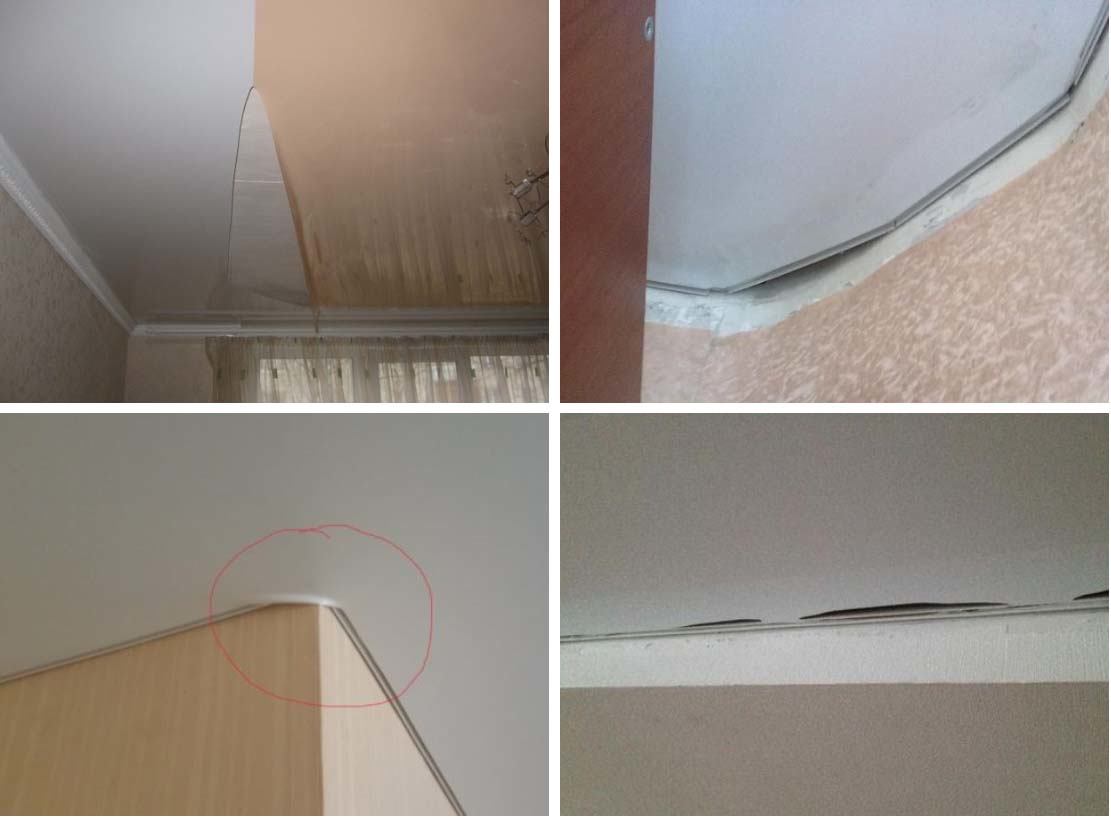
But most of the controversy arises about the warranty case or not. A puncture, cut, rupture associated with the actions of the owner of the apartment will not be repaired free of charge. But any marriage will have to be eliminated: insufficiently reliable fastening of the holding profile, poor-quality components, poor tension, defects left by the tool during installation.
What cases are covered by the warranty
The repair is carried out free of charge when defects have arisen through the fault of the manufacturer or installer. The main situations are as follows:
- The seam between the cuts of the PVC film has spread.
- The stretch ceiling frame moves away from the wall.
- The film or fabric is poorly tucked into the baguette.
- The harpoon is not well soldered.
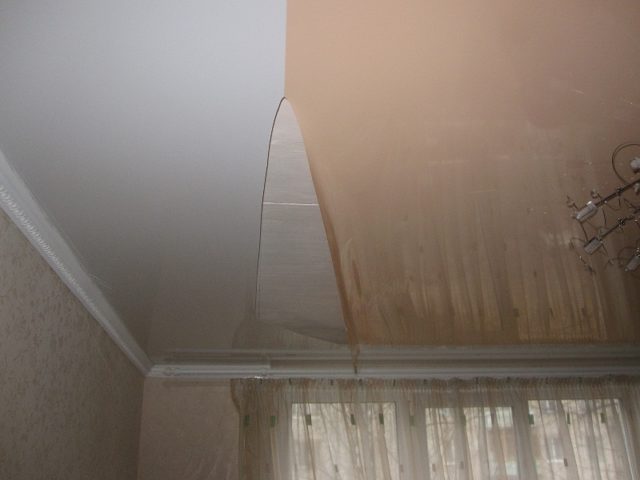
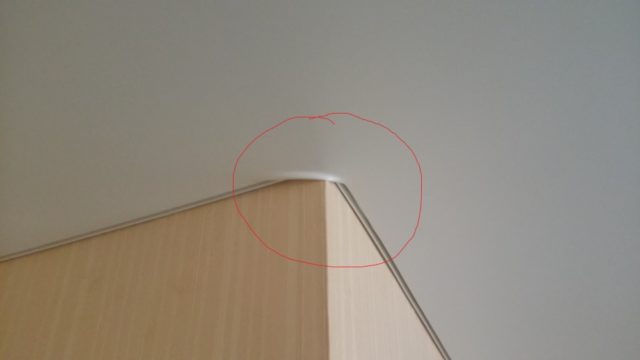
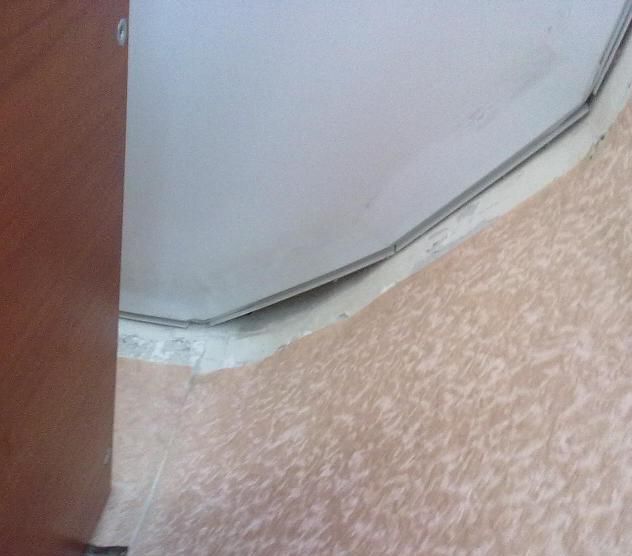
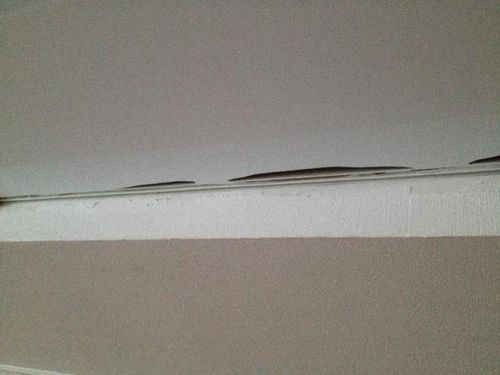
In the first case, the manufacturer gives a guarantee for the quality of the soldering and is obliged to install a new blade free of charge. In other situations, warranty repairs are performed.
Another possible cause of damage is loose pieces of plaster or other finishes.
In this case, it is important who was involved in the preliminary work. If the installation company of the ceiling, then the craftsmen must eliminate the consequences for free
And with self-preparation, you will have to pay for repairs.
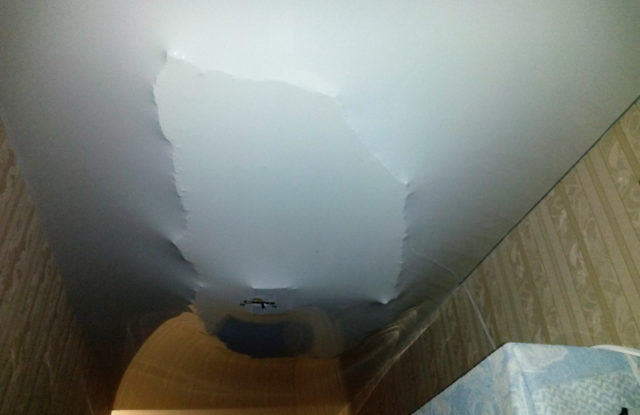
Non-warranty cases include the following situations:
- inaccurately mounted a cabinet or cornice and pierced or cut the film;
- homeowners dismantled the ceiling on their own and damaged the canvas;
- the neighbors made a flood and the film burst under the weight of the water.
With careless handling, the stretch ceiling is easily pierced and torn. It can also crack from excessive pressure. But often a complete replacement is not required, it is enough to make a cosmetic repair. Some works are even covered by the warranty.
Situations when repair is impossible
Some damage to the stretch ceiling cannot be repaired: in this case, you will have to completely change the canvas.
These are the following situations:
- The seam is cracked. All attempts to glue the material will only aggravate the situation. This defect can only be eliminated by re-tightening the material.
- If the stretch ceiling has moved away from the wall. A very difficult breakdown, which will require a complete dismantling of the system. The removed profiles and moldings must be reinforced or replaced.
The best way to repair a stretch ceiling cut is to prevent it from appearing. If an unpleasant situation still occurs, before starting an independent repair, you need to soberly assess your strength. If you are not confident in your own abilities, it is better to call professionals. It often happens that clumsy repairs make the situation even worse.
Possible difficulties
Tears and punctures in fishing equipment may need to be repaired.It is difficult to remove the remnants of the previous fixing compound, the adhesive bonds to the base at the molecular level. When cleaning the surface, do not use force, mechanical impact can lead to damage, increasing the rupture area.
It is worth abandoning aggressive compounds, solvents. It is best to use abrasive materials, such as zero-grade sandpaper. Remove glue residues very carefully so as not to damage the base.
Rules for working with glue:
- First you need to degrease the surface - a solvent, acetone or gasoline is used. It is better to sand the edges of the seam to be fixed with sandpaper for better fixation. Neoprene products are only solvent coated, do not require abrasive paper.
- To speed up the bonding process, it is worth using a construction or ordinary hair dryer - the hot air flow activates the process.
- You need to work with various adhesives in a well-ventilated area. It is possible to repair equipment outdoors, provided the humidity is no more than 50%, the temperature is from 15 to 25 ° C.
- To check the quality of the repair done, you do not need to go to nature. It is enough to use a flashlight or desk lamp. Enter a dark room, place a light source inside a jumpsuit or boot. It is recommended that you check your equipment before every fishing trip.
Share link:
When to change a stretch ceiling
Not all cases of mechanical damage can be repaired. The PVC ceiling film will have to be completely changed if:
- The film has broken through the seam. Moreover, the extent of the damage is too large and the canvas continues to diverge.
- Neighboring flood. Only high-quality PVC canvases can withstand water. After removing moisture and drying, such a film quickly returns to normal. But the fabric ceiling coverings when flooding from above will have to be changed completely. The fabric absorbs dirty water and, after drying, becomes untidy, loses its appearance and becomes covered with ugly stains.
- Holes too large. When neither patches nor appliqués can save the day.
- End of service life. On average, a stretch ceiling is designed for 10-15 years of service. After this time, the ceiling material gradually loses its quality and deteriorates.
Strength characteristics of different types of canvases
It is much more practical to initially take all measures to prevent damage to stretch ceilings than to heroically eliminate them later. One way is to choose the most durable material.
Tension canvases are of two types:
- Tissue. Raw materials for their manufacture are natural or synthetic fibers with a porous surface. This allows the ceiling to breathe. The material copes well with temperature fluctuations, mechanical stress and can be additionally painted. This allows you to hide the butt section (if any) and eliminate minor damage. The disadvantages of fabric panels include their weak resistance to external pressure, weak elasticity and limited decorative equipment in terms of effects and shades. The fabric allows water to pass through, so when flooded from above, all the liquid is in the room.
- PVC films. Due to their high elasticity, they do an excellent job with high pressure, hide the flaws of the main overlap well, do not accumulate dust on their surface. They can be washed with a soft sponge without using aggressive products. Weaknesses of PVC stretch film are susceptibility to mechanical damage, sensitivity to temperature fluctuations and the complexity of repair.

We carry out the correction
There are several ways to eliminate trouble after damage to the ceiling sheet.
Method number 1
- We select nylon threads in the color of the ceiling installed in the room.
- We apply a neat, precise seam using a nylon thread.
Method number 2
- If you have pieces of material left after installing the stretch cover, use them. If not, use soft, thin plastic.
- Decide how you want to glue the patch, and what shape it will be. If the cut is in a corner, it is best to make a curly element and apply it in all corners of the room.
- Glue the cut out patch with super glue. Use appliques as a patch.
How to fix a small puncture?
A small hole in the PVC ceiling can appear if you carelessly work with tools. Such damage can be repaired regardless of the material from which the coating is made.
Before starting work, it is necessary to fix the damaged area with tape. This will prevent the hole from growing in size. If the damage is somewhere in an inconspicuous place, then you can simply glue it with a circle cut from an identical material. This will help restore the tightness of the coating. If such a patch matches the color of the ceiling, it will be invisible from a distance of more than 3 meters. If the puncture is located on a noticeable part of the ceiling, then when repairing over the patch, you can simply stick a beautiful PVC applique on top. It will hide the defect and give the surface an aesthetic appearance. To make this design seem visually complete, you can add a few more similar decorative elements.
How to glue PVC applications? For this purpose, a special adhesive is suitable. First, the surface of the film must be degreased. Do not use building solvents as they can damage the material. Mild detergents work well. The adhesive should be used in accordance with the instructions on the packaging. As a rule, these are quick fix formulations that set to the surface within a few seconds. If the patch is incorrectly installed, the repair procedure will have to be repeated. The patch is glued directly to the ceiling covering. After setting, the adhesive layer hardens and forms a kind of reinforcing layer, which prevents further increase in the size of the damage.
Close up the cut
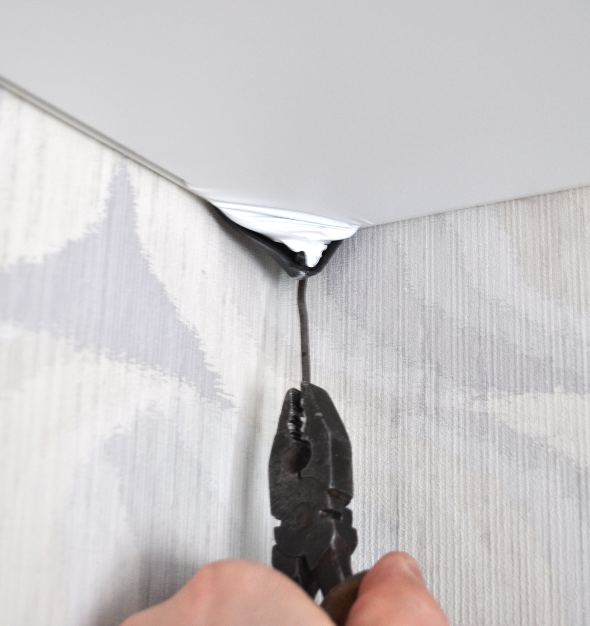
This aspect should be given special attention. Suppose there is a small cut on the stretch ceiling
What to do in this case? If the defect appears in a part of the ceiling located far from the edge of the wall, then you can try the following method: install a lamp or a ventilation grill in place of the hole. To prevent further stretching of the PVC film, experts recommend attaching a plastic ring around the hole. Its inner part must be cut out in order to install the luminaire. This method is especially effective for minor injuries.
The easiest and easiest way to hide damage is to install spotlights. This is done quite simply and does not take much time. Difficulty can arise only when laying additional wires under the covering. But even if this does not work, do not despair. A non-burning lamp will still look better than a damaged ceiling.
To achieve more convincingness, you can install several luminaires, observing the principle of symmetry. Then they will look as if it was the original idea of the designer.
It is important to calculate and plot everything correctly.
To install the shade, you need a simple utility knife and plastic glue. Lamps are equipped with decorative rings. The cut should be inside this element. We just coat its contour with glue and apply it to the damaged ceiling.
The adhesive composition sets fairly quickly. After a few seconds, it will be possible to cut holes inside the ring and place a lamp there. Try not to leave excess glue on the surface. When they dry up, it will be impossible to clean them.
This is the easiest way to glue a stretch ceiling after a cut. Unfortunately, its use is justified only for small damages, suitable for the size of the fixtures. If we are talking about a large cut, you will have to use more radical methods.
Ways to eliminate cuts
Repairing a stretch ceiling cut is not a difficult task, but it requires accuracy and precision of movements. The way to solve the problem depends on where the cut is: not far (no further than 30 cm) from the baguette, or at a considerable distance from it.
If the cut is near a wall
- The edge of the film opposite the problem area is removed from the baguette. Then another 20-25 cm of the film is taken out on the left and right. It is found that its edges are wound into a harpoon, a strong elastic strip, which is inserted into the baguette.
- With a sharp knife (preferably a clerical one), cut the film along the bottom (back) of the harpoon. That is, they cut it off, the so-called "skirt".
- A smooth, gently sloping line cut off a place with a defect.
- Apply glue to the harpoon and gently, evenly glue the canvas to it. This is how the cuts are sealed on stretch ceilings, where the problem area is at the baguette.
- Next, using an ordinary hair dryer, heat the film, stretch it, tuck it into a baguette. For refueling, you will need a spatula, the blade of which will have to be made blunt and rounded.
If the cut is far from the wall
Repairing stretch ceilings after a cut away from walls requires a piece of film similar to the stretched one. You will also need glue and scissors. Eliminate the visual flaw of the canvas only by applying a patch. So you have to cut and glue. There is no other way to repair stretch ceilings after a cut with your own hands.
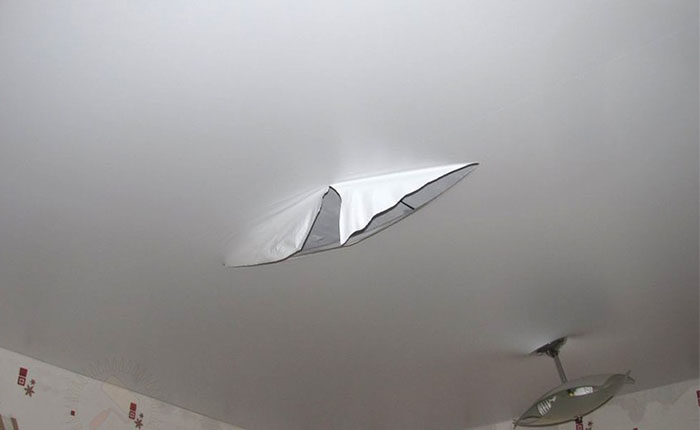
The result of the work may not please. But this problem can be solved. Today there are many different, beautiful and lightweight accessories for decorating walls and ceilings on sale. Some of the most popular are spectacular butterflies. You can choose the one suitable for the interior design and glue it to the patch.
We figured out how to remove a cut on a stretch ceiling. Now you need to understand what kind of glue to use in your work.
Types of glue for repairing stretch ceilings
Experts from manufacturers recommend stopping your attention on the COSMOFEN or COSMOPLAST adhesives lines, and only with their help to restore the stretch ceiling, repair cuts and eliminate holes. The most suitable for these works are COSMOFEN CA 12 and COSMOPLAST 513, 500, 500L
The first one (COSMOFEN) is designed for use by window plastic installers. The COSMOPLAST series allows you to choose the glue that is most convenient in terms of hardening time. This is a very important point, since the speed of work is different for everyone.
For those who are leisurely and focused on quality and accuracy, COSMOPLAST 500 or 500L are suitable. Their solidification time is 3 and 4-5 seconds, respectively. If the work needs to be done quickly, but with possible further adjustments, it is recommended to use COSMOPLAST 513, the setting time of which is about 15 seconds. Enough to fix something.
Craftsmen who repair a stretch ceiling successfully remove a cut using inexpensive types of glue. They consider "Contact" one of the best, and recommend to beginners to use it. With the help of this glue, it is most convenient to repair stretch ceilings with your own hands. "Contact" is absolutely transparent, quickly grasps, but there is time for correction.

What types of deformation are considered a warranty case
If the damage to the ceiling film has arisen due to improperly performed work, the repair of the stretch ceiling is covered by the warranty. The installer is obliged to replace the PVC sheet in the following situations:
- the butt seam between the PVC film canvases has come apart;
- the frame of canvases began to move away from the wall;
- the film or fabric is poorly tucked into the used baguette;
- the harpoon attachment system used during installation was poorly soldered and began to come off.
All such situations are guaranteed and are subject to free repair or replacement. But they must be spelled out in the contract, so carefully study the agreement before carrying out installation work.
If the panel is torn during independent subsequent repairs, removal of furniture, installation of tall cabinets or due to the fault of neighbors who arranged a flood, the coating will have to be repaired by our own efforts. Fortunately, a complete replacement of the canvases is not always required; in many cases, holes and cuts can be imperceptibly sealed.
Fabric ceiling and its features
So what do you need to know about this? Fabric ceilings are not as popular today as vinyl flooring. There are several simple reasons for this. First, the fabric cover is more expensive. Depending on the type, the price for such material can be several times higher than the cost of PVC film. Secondly, if the neighbors flood you, an ugly stain will remain on the surface of the ceiling, which will be impossible to get rid of. Thirdly, the installation of such ceilings is particularly difficult. Unlike vinyl, fabric does not expand much when heated. It will be much more difficult to stretch such a ceiling. In addition, the fabric cover cannot have a glossy sheen.
Most often, this finishing option is preferred by lovers of environmentally friendly natural materials. With regard to damage, then one of the situations described above may well occur here. In this regard, an absolutely natural question arises: "How to glue the fabric?"
What to do if the stretch ceiling has moved away from the wall?
This happens for several reasons. Most often this is due to the poor quality of installation work. The harpoon system is more convenient for assembly, but not strong enough, especially if the stretch ceiling has been dismantled and reassembled several times. The gap also appears as a result of building shrinkage or deformation of supporting structures (walls, partitions). If you've hired builders, chances are you don't have the tools you need to get the job done.
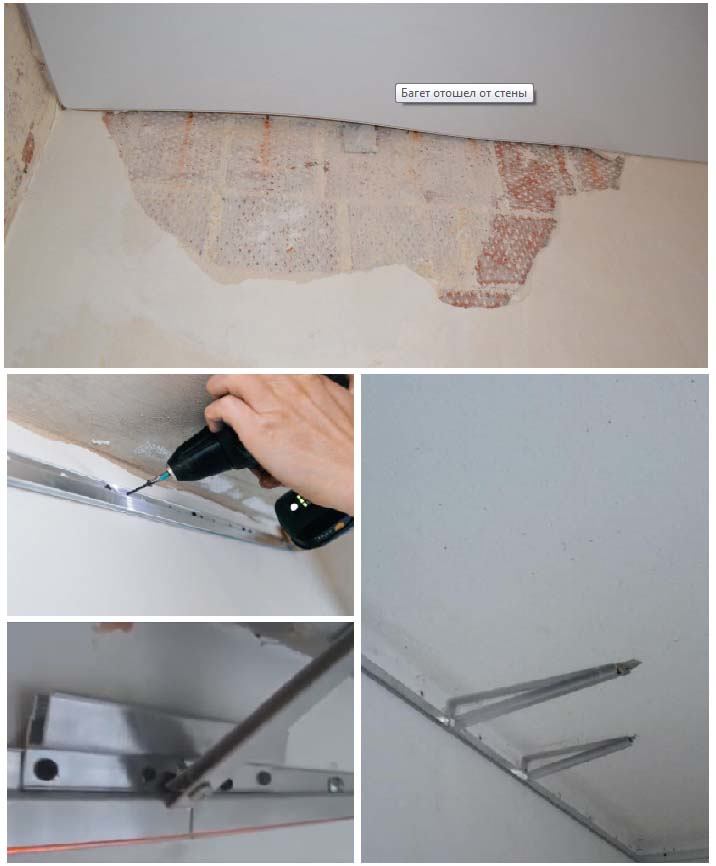
The stretch ceiling will have to be completely or partially disassembled:
- Fully. It is supposed to remove the web with the subsequent dismantling of the profile. Sometimes it needs to be replaced.
- Partial. It happens that it is necessary to change the harpoon when the gap has formed due to the fact that the mount has "spread".
If you assembled the structure yourself, it means that the tool is stored in your pantry, workshop, garage, closet. The technology is known and the work is done without the involvement of specialists. When the marriage is associated with the contractor's negligence or the use of substandard materials, re-read the contract. If the warranty has not expired, ask to fix the problem free of charge.
Repair of punctured PVC foil ceiling cladding
If the damage is not in a visible place, then on the film finish, you can simply seal the hole with a circle cut from an identical material - this will prevent further enlargement of the hole and restore the tightness of the vinyl cladding. Such a patch, if it matches the color of the area being repaired, is invisible from a distance of more than three meters. If the puncture is located on a closely located section of the ceiling, then when repairing by gluing over the repair patch, it is better to glue a beautiful application of PVC film, which will not only hide the defective spot, but also add artistry to the finishing of the ceiling surface. Often, such a design of the repair site requires several more similar decorative elements to be added to the stretch ceiling for visual completeness.
Adhesive for repairing damage in vinyl canvases is commercially available in a wide range, since it is quite possible to seal a small hole in a stretch ceiling on your own.
The instructions for using the adhesive are on the packaging and must be followed exactly. These adhesives are fast-fixing materials, that is, they set within a few seconds, therefore, if the patch is inaccurately installed on the hole or if the adhesive is delayed after applying the composition, the repair procedure will have to be repeated, possibly with the manufacture of a new patch.
The patch is glued without dismantling the casing, directly onto the installed foil. After setting, the adhesive layer hardens and forms a hard reinforcing layer, which prevents further increase in the size of the damage under the influence of pretension forces.
Causes of damage
The tensioning web is constructed as follows - a metal frame on which the web is stretched. With this design, an empty layer remains between the ceiling and the fabric, due to which the canvas becomes vulnerable both from the outside and from the inside.
The material of the panel can withstand a large tensile load, but under point impacts it has low strength.
Common causes of mechanical damage to the web include:
- Damage from toys or other objects during the games of little pranksters. Flying remote controlled toys are especially dangerous.
- Hitting when installing tall furniture with sharp corners.
- Large differences in air temperature in the room (relevant for the film ceiling).
- Damage from a sharp object, such as a tool, resulting in a cut or puncture.
- Errors in the process of cutting the canvas or when installing the ceiling.
You can also damage the surface by making a mistake when installing built-in lamps and, if you move inaccurately, by sparks from sparklers or another source of fire. In this case, the ceiling covering will be the easiest to glue.
Rules for working with a fisherman's costume
Sooner or later, every fisherman is faced with damage to his fishing suit or wading boots. Completely changing your equipment is not the best option, it is worth trying to restore the integrity of the equipment.
Rubber suit repair:
- You will need an old rubber boot - cut the patch to the correct size.
- Use sandpaper to clean the area requiring repair, as well as the patch itself.
- Degrease the patch and the damaged area of the rubber suit. Gasoline, acetone, solvent are used. It is best to work with rubber gloves, which also need to be processed.
- Apply rubber glue to the patch and the damaged area of the suit. It will take 20-30 minutes to dry the composition, the patch is not attached to the area requiring repair.
- After the specified time has elapsed, apply a second layer of glue. Then the patch is applied to the damaged area. Leave until completely fixed for several hours. The glue dries quickly, but the wading suit can be used in a day.
Membrane suit repair
Special compositions based on neoprene and polyurethane are used to repair overalls not only from a membrane, but also from PVC. Effectively seal seams, abrasions, holes of different diameters.
Membrane suit repair:
- Cut a patch out of nylon or other synthetic fabric that is identical to the damaged area.
- Turn the product inside out. Apply adhesive tape to the area with the hole.
- Then turn to the front side, fill the hole with glue.
- Put the prepared patch on top.
- Wait a few hours and once again apply glue on the front side for a stronger fixation.
Wader repair
The angler's rubber pants are waders, vulnerable to damage to branches and reeds in water bodies, often tearing along the seam. For repairs, a specialized glue is used, developed for the quick restoration of fishing equipment.
How to glue neoprene waders:
- Turn the suit over to the wrong side.
- Use scissors to cut the area around the thinning area on the overalls with an allowance of 1 cm.
- Attach the resulting part to the patch of new neoprene, circle it with an allowance of 3-5 mm. Cut the patch along the contour.
- Put on the waders and try on the workpiece, if it fits the size of the hole, start preparing the material.
- Treat the damaged surface with a hardener cleaner or acetone.
- Glue is applied to the borders of the patch and holes. Apply end-to-end, not overlap, the fixing time is indicated in the product instructions.
- Additionally, the joint is stitched with nylon thread and processed along the outer and inner edges with glue.
- Wait a day; after the glue has dried, turn out the wading pants and check the quality of the repair. The neoprene should lie flat on the front.
Popular brands of wader repair products are Aquasure, Stormsure, Technisib. Designed for express repairs, restoring tightness and elasticity to the product. Designed for repairing neoprene, fiberglass, rubber and soft PVC coveralls.
Repair of seams:
- Treat material with solvent.
- Apply specialized glue along the seam with a thickness of 1 mm.
- Work out the joints with a brush so that the fixing compound covers the seam by 3-5 mm.
- Process the seams from the inside in the same way. By analogy, areas with scuffs are restored.
- Leave to dry for a day.
Repair of a puncture in a fabric ceiling
What is special? Stretch ceilings made of fabric have a polyester base, which provides localization of minor damages and facilitates subsequent repairs. If the canvas was not damaged during the puncture, you can simply fill the resulting hole with sealant.
In case of damage to the base, the fabric should be sewn up using synthetic threads, matched in thickness and color. For white fabrics, white nylon thread is best suited. If the damage is in a conspicuous place, you can perform a full painting of the coating. You can also disguise the repaired area by applying an applique or artistic drawing to it.
Reasons for damage to the stretch ceiling
Stretch ceiling is a suspended structure with a film stretched on it. This material visually appears to be strong and sturdy. However, this is a misleading impression. The film must be handled carefully and carefully. But only installers who work with this material every day know about this. Consumers, on the other hand, do not attach due importance to the rules for operating a stretch ceiling.

The most common causes of film damage:
- the formation of stretch marks and holes during skidding, removal, assembly of furniture;
- cuts and holes during the installation of interior and exterior doors, installation of slopes and platbands;
- the release of the film from the baguette due to inaccurate replacement of lighting fixtures or other actions;
- stretching the film and its exit from the baguette during flooding from above;
- cuts and punctures of the canvas due to too active children's games with tossing sharp-angled objects.
For stretch ceiling owners, it is important to know what actions can lead to damage to the film. But everything cannot be foreseen
In most cases, one or another trouble with a thin film cannot be avoided. And here knowledge about how to repair a stretch ceiling will help out.
Types of damage and ways to eliminate them
In order to fully represent the scale, labor intensity and financial cost of the upcoming work, we will consider how to repair stretch ceilings in each specific situation. There are several problems requiring attention:
- a cut;
- hole;
- exit from a baguette or other attachment;
- melting or burn-through;
- stretching;
- puncture.
The stretch ceiling to be repaired must be properly prepared. If the cut is removed, the edges of the canvas are pulled and glued. If it is a hole, it will take creativity, which often requires cutting the film.Each type of action will require its own materials and tools.
Ways to decorate the damaged area
Sometimes it is possible not to repair, but to mask the place of the defect. This only applies to the ceiling, torn or cut in a place where you can hide a flaw or install a lamp, applique or ventilation grill in this place. In this case, you do not even have to use a hairdryer for repairs, because after decorating the surface will not sag and deform.
But if the installation of a luminaire or lattice is considered a more radical method, then various decorating techniques allow you to hide defects without interfering with the ceiling structures.
There are the following ways to decorate the cut stretch ceiling area:
- In the case of localization of the defect near the base of the chandelier, this area can be hidden behind the ceiling stucco or other base under the hinged lighting device. Just do not use stucco from heavy materials, it is better to give preference to lightweight foam elements.
- Coloring is also considered a decorating technique. But this method is only suitable for stretch ceilings made of polyester fabric. It is prohibited to paint PVC film.
- Small holes can be sealed with a colored film applique. A scattering of butterflies or flowers on the ceiling will not only hide the defect, but also add originality to the entire ceiling surface.
There are different ways to repair cut stretch ceilings. Depending on the size of the defect, the place of its localization and the coating material, a decision is made on the choice of one or another method of repair or on the complete replacement of the ceiling finish.
Summing up
A stretch ceiling cut is an unpleasant problem, but anyone can face it. The main reasons are mechanical damage during the installation and operation of the stretch ceiling, and factory defects.
There are two types of cuts: fabric-backed and film-backed.
There are several ways that you can easily remove a cut without using professional tools and materials.
The main thing is accuracy and attentiveness when performing work, then the result will meet expectations. Otherwise, it may be necessary to install a new stretch ceiling, which will entail additional financial costs. The installation of a new tension blade is required if the cut is too large.
If you carried out the installation of the stretch ceiling with the help of professionals, then it is more expedient to entrust the correction to them. Performing it yourself, you lose warranty service in the company whose services you used. If problems arise related to improperly performed installation or material, the procedures will have to be carried out using your own financial resources.
To resort to the help of professionals or not is a private matter for everyone. Work of this kind can be carried out independently. I wish you success!

